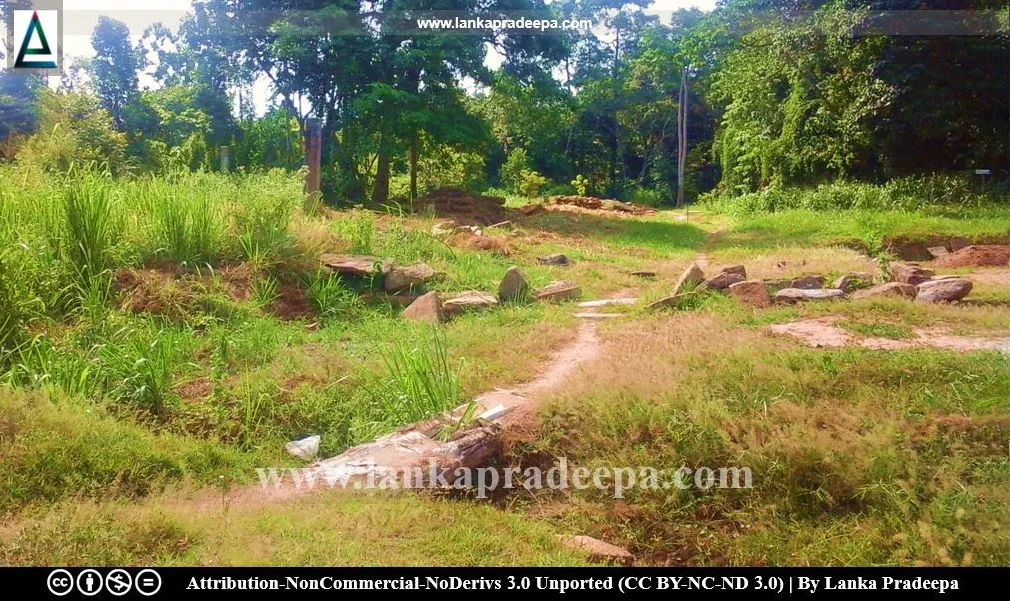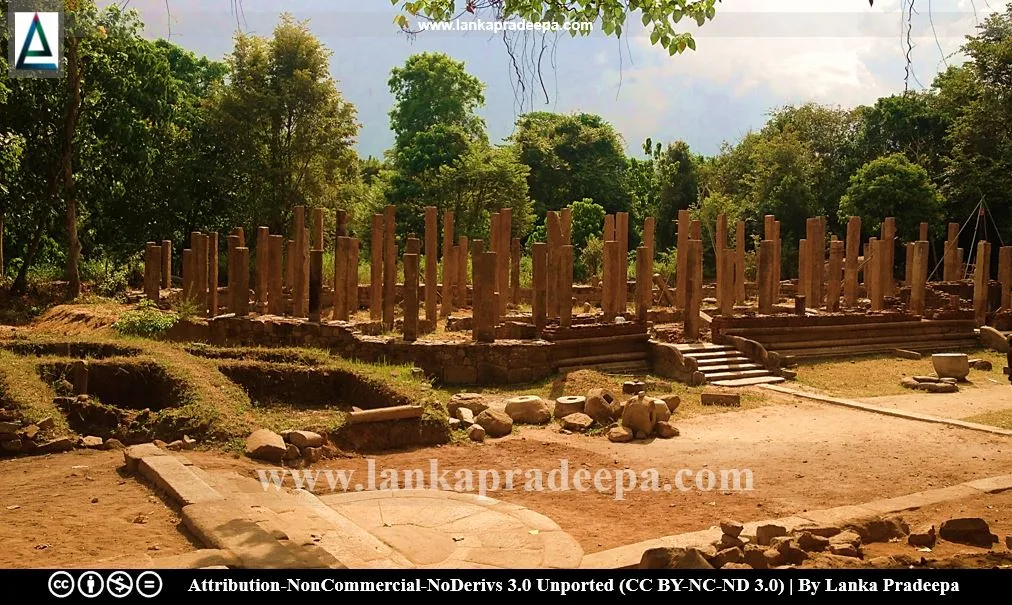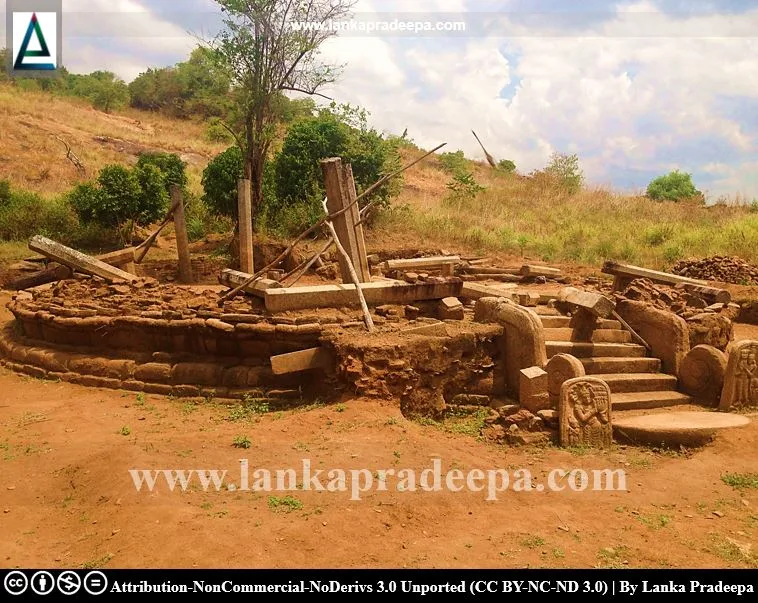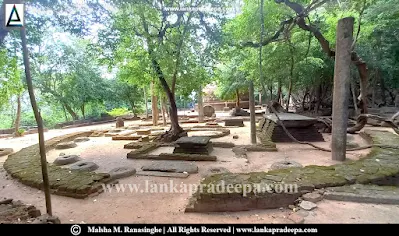
|
Rajagala Archaeological Site |
Rajagala (lit: The monarch rock; Sinhala: රජගල) or Rassahela is the modern name used for the ancient Ariyakara or Girikumbila Viharaya, a ruined Buddhist monastery complex situated in Uhana Divisional Secretary's Division in Ampara District, Sri Lanka. The site can be reached by travelling about 1.5 km distance from the Bakkiella junction which is on the Ampara - Mahaoya main road located about 26 km from Ampara town. The ruins of the ancient monastery spread over an area of about 1,025 acres on Rajagalakanda [316.38 m (1,037.99 ft. amsl)], one of the auxiliary mountain ranges in the Gal Oya-Digamadulla region (Alexander et al., 2020; Karunarathna, 2021).
The site is being conserved by the Department of Archaeology with the full cooperation of the University of Sri Jayawardanapura. The government of Sri Lanka as well as the American Ambassadors Grant for Cultural Preservation for years 2013 and 2015 have provided financial provisions for this process. The site was submitted to the Tentative List of World Heritage Sites in 2020.
Names
Rajagala, the present name of the monastery has come into the parlance recently. During the past period, various names have been used to identify this location (Kapukotuwa et al., 2018). Girikumbila Viharaya, Kubilapi-Tisapavata Viharaya, Ariyakara Viharaya, Ariyakoti Viharaya, Ariththara Vehera, Tissamaha Vihara are some such names mentioned in several Buddhist texts, chronicles and inscriptions (Kapukotuwa et al., 2018; Medhananda, 2003; Paranavitana, 2001; Ranawella, 2005). These names were used in the Anuradhapura Period but may have been forgotten from the memories with the passage of time. Also, a Later Brahmi Inscription at the site mentions "Racakala" (Raksa-gala) as the locality where the Kubalavi-tisa-pavata (present Rajagala) is located (Paranavitana, 2001).
Rajagala Rock Inscription of Arittara Vehera

Period: 8-10 centuries A.D.
Transcript: Svasti Senhu vajanin A(ritta)ra vehera vasi vat-himiyanat satarpasa vayutu karana kot.....>>
Translation: Hail! By the order of Sen. In order to provide the four requisites for their lordships residing in the Arittara monastery ......>>
Notes: This inscription (right photograph) records a grant by a local ruler of Rohana, to the monastery called Arittara Vehera.
Citation: Paranavitana, 1934




History
A Pre-historic Site
The prehistoric man had used the caves at Rajagala Mountain as their dwellings before the site was developed into a monastic premises (Karunarathna, 2021). A Megalithic Cemetery has been discovered in the Bandaraduwa flatland area located near the Rajagala archaeological site (Karunarathna, 2021). During the excavations done in Mahalena Cave at the site between 2016-2018 by the University of Sri Jayewardenepura and the Archaeological Department in collaboration with other foreign universities, several artefacts belonging to the prehistoric and mid-early historic periods have been identified (Alexander et al., 2020; Karunarathna, 2021).
Establishment of the Buddhist Monastery
According to the information revealed by the chronicles and inscriptions in situ, the Buddhist monastery at Rajagala was founded by Prince Lanjatissa (reigned 119-109 B.C.), the eldest son of King Saddhatissa (137- 119 B.C.). Chronicles such as Mahavamsa and Dipavamsa mention that Prince Lanjatissa commenced the establishment of the Girikumbila Viharaya during the period 167-137 B.C. when he was a prince living in the Digamadulla region and handed it over after completion to the Buddhist priests in between 116-109 B.C. Mahawamsa further gives detail about the inauguration ceremony of the Girikumbhila Viharaya. It states that the king donated six garments each to sixty thousand Buddhist monks who attended the ceremony (Dias, 2001). Several inscriptions that have been found on the site record further donations made to the monastery by Lanjatissa and his wives such as Buddhadatta, Shamika, Yahasini, etc. (Nicholas, 1963; Paranavitana, 1970; Sirisoma, 1990).
Rajagala Cave Inscription of Buddhadatta
Period: 2nd-1st centuries B.C.
Script: Early Brahmi
Language: Old Sinhalese
Transcript: Devanapiya maharajhasa Gamini Tisaha Puta Maha[yasajhaya upasi]ka Butadataya lene aga[ta ana]ga[ta catu] di[sa] sagasa
Translation: The cave of the female lay devotee Buddhadatta, wife of Mahaya, son of the great king Gamani Tissa, the friend of the Gods, [is given] to the Sangha of the four quarters, present and absent.
Notes : Lanjatissa is denoted by Maha aya
Reference: Paranavitana, 1970.
Rajagala cave inscription of Shamika
Period: 2nd-1st centuries B.C.
Script: Early Brahmi
Language: Old Sinhalese
Transcript: Devanapiya maharajhaha Gamini Tisaha Putaha Tisa ayaha jhaya upasika Samikaya lene
Translation: The cave of the female lay devotee Samika, wife of prince Tissa, son of the great king Gamani Tissa, the friend of the Gods.
Notes : Lanjatissa is denoted by Prince Tissa
Reference: Paranavitana, 1970.
Royal Patronage
After being founded by Prince Lanjatissa, Girikumbila Viharaya received the royal patronage of the kings of Anuradhapura as well as the viceroys of Ruhuna territory (Ranawella, 2005). An inscription indited on a rock at a later period records a grant made to this temple by Kutakanna Tissa (41-19 B.C.) before he ascended the throne (Dias, 2001; Paranavitana, 1983). Mahadathika Mahanaga (7-19 A.D.), and Mahasena (276-303 A.D.) are the several names of the kings who are recorded in inscriptions at the site (Paranavitana, 1983; Paranavitana, 2001). Historical resources prove the existence of the monastery during the period of King Dappula I (659 A.D.) and King Udaya I [(797-801 A.D.) Karunarathna, 2021].
After its establishment, no reference has been made in Mahawamsa regarding the temple until seven centuries. However, the information available in other literary resources as well as in the inscriptions in situ and nearby areas is important in bridging this gap. Literature sources such as Sahassavattupakaranaya, Rasavahini, Attakatha, and Saddharmalankaraya contain several stories related to Girikumbila Viharaya (Kapukotuwa et al., 2018). The tale of Mahadatta Thera, Ariyakara Vihara Vasthu, and the story of Dhamma (in Rasavahini) give some information connected with the monastery.

Rajagala Rock Inscription of Saint Mahinda
About 70-100 inscriptions have been discovered so far in Rajagala (Medhananda, 2003; Paranavitana, 1970; Paranavitana, 1983; Paranavitana, 2001; Ranawella, 2005). Among them, the rock inscription regarding the Arhat Mahinda Thera [(also called Mahendra (Sanskrit) or Mihindu] is historically important and considered the most valued inscription of archaeological interest found in the monastery (Karunarathna, 2021; Medhananda, 2003).
Period: Circa 200 B.C.
Script: Early Brahmi
Language: Old Sinhalese
Transcript: Ye ima dipa paṭamaya idiya agatana Iḍika-[tera-Ma] hida-teraha tube
Translation: This is the Stupa of Elder Ittiya and elder Mahinda, who came to this island by its foremost good fortune.
Note: The inscription mentions Mahinda and Itthiya, the names of the two of seven missionaries who brought Buddhism to Sri Lanka as described in the ancient chronicles (see Mihintale).
Reference: Paranavitana, 1962
This inscription marks the spot where the Stupa (Mihindu Seya) was erected over a portion of the relics of Arhat Mahinda Thera (Kapukotuwa et al., 2018). Senarath Paranavithana who edited this inscription presumes that the Stupa located adjacent to this inscription (right picture) may have been built soon after the demise of the Arhat Mahinda (Paranavitana, 1962). The Mahawamsa says that after the cremation of Arhat Mahinda, the relics were enshrined in Stupas throughout the country. The aforesaid inscription confirms this fact given in the Mahavamsa (Medhananda, 2003).


Destruction
The monastery complex went wild after the South Indian invasions in 993 and 1017 and since then it gradually deteriorated due to natural causes and also due to vandalism by treasure hunters.
Ruins

Besides the ancient cities of Anuradhapura and Polonnaruwa, Rajagala is considered another place where a large number of archaeological monuments are concentrated. It is also the only place in the country where an inscription confirms the enshrinement of the relics of Arhat Mahinda Thera, the Buddhist monk who brought Buddhism to Sri Lanka during the reign of King Devanampiyatissa (247-207 B.C.).
All the structures and buildings found in Rajagala belong to the Anuradhapura Period. Ruins ranging from the 2 century B.C. to the 11 century A.D. have been identified (De Silva, 1990). In a recent study, about 593 monastic remains have been identified at the site scattered in an area of 400 hectares. These ruins indicate that Rajagala was a monastery of Pabbatha Vihara and Vanavasa style with cave dwellings depicting an ancient mediation monastery.

The monastic structures at the site include Stupas, Alms-halls, Uposathaghara, Janthaghara, Asanaghara, Bodhighara, other religious & service buildings, pathways, stone stairways, and monks’ residences in caves (Kapukotuwa et al., 2018). The site also consists of several ponds to collect water in several locations and also a small tank in the common area. The building in which large stone bowls are found is identified as a special building in the monastery which is still in operation. It has been used for the collection of spring water for cooking and drinking purposes. The special cave carved to look like an umbrella (Kuda lena) to assemble the people to hear the preaching of monks is also considered a rare monument.







Related Posts
Read Also
References
Books, Government Gazette Notifications, Journal Articles
1) Alexander, K.M., Ranasinghe, G., Abeynayake, M.D.I.K., Suranga, E.G.J., Satish, S., 2020. Reviewing the Paleo-Biological remains of Rajagala Mahalena Cave in the Eastern Province of Sri Lanka. Trivalent: Journal of Archaeology, Tourism & Anthropology, Department of Archaeology, University of Kelaniya Volume I,. Issue I.pp.35-47.
2) De Silva, R., 1990. Painting (Early period 247 B.C. to 800 A.D.). Nandadeva W. (Editor in chief), Archaeological Department Centenary (1890-1990): Commemorative series (Vol. V). Painting. p. 31.
3) Dias, M, 2001. The growth of Buddhist monastic institutions in Sri Lanka from Brahmi inscriptions. Epigraphia Zeylanica, Vol. VIII.
Department of Archaeology Survey. ISBN: 955-9264-04-4. p.48.
4) Kapukotuwa, A., Ranasinghe, G., Shinde, V., Jadhav, N., Ganvir, S., Delavi, H., Rao, V., Chatterjee, M., Tomar, H., 2018. Preliminary Report on Rajagala Archaeological Research Project. Journal of Indian ocean archaeology no, 13(14), pp.101-143.
5) Karunarathna, H.H.A., 2021. A Study on the Cultural Landscape of Rajagala Monastic Complex in the Eastern Province of Sri Lanka. Archaeology. South Asian History, Culture and Archaeology, 1(1), pp.35-49.
6) Medhananda, E., 2003. Pacheena passa - Uttara passa: Negenahira palata ha uturu palate Sinhala bauddha urumaya (In Sinhala). Dayawansa Jayakody & Company. Colombo. ISBN: 978-955-686-112-9. pp.232-238.
7) Nicholas, C.W., 1963. Historical topography of ancient and medieval Ceylon. Journal of the Ceylon Branch of the Royal Asiatic Society, New Series (Vol. VI). Special Number: Colombo. Royal Asiatic Society (Ceylon Branch), p.27.
8) Paranavitana, S., 1934. Three rock inscriptions at Rassahela. Epigraphia Zeylanica: Being lithic and other inscriptions of Ceylon (Vol. IV). Archaeological Survey of Ceylon. pp.169-176.
9) Paranavitana, S., 1962. An inscription of circa 200 B.C. at Rajagala commemorating saint Mahinda. University of Ceylon review by Ceylon University Press. pp.159–162.
10) Paranavitana, S., 1970. Inscriptions of Ceylon: Volume I: Early Brahmi Inscriptions. Department of Archaeology Ceylon. pp.lx,33-35.
11) Paranavitana, S., 1983. Inscriptions of Ceylon, Late Brahmi Inscriptions, 2 (part 1). Archaeological Survey of Sri Lanka. pp.2-4,15-16.
12) Paranavitana, S., 2001 (Edited by Dias, M.). Inscriptions of Ceylon: Vol. II. Part II. Archaeological Survey Department, Sri Lanka. pp.193-194,259-260.
13) Ranawella, S., 2005. Inscription of Ceylon. Volume V, Part III. Department of Archaeology. ISBN: 955-91-59-57-7. pp.114-115,136-138,145,157.
14) Sirisoma, M. H., 1990. Brahmi inscriptions of Sri Lanka from 3rd century B.C. to 65 A.D. Nandadeva W. (Editor in chief), Archaeological Department Centenary (1890-1990): Commemorative series (Vol. II). Inscriptions. p. 23.




